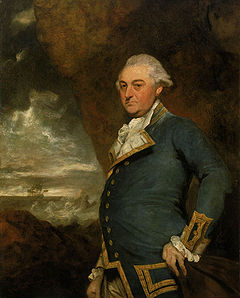Raid on Genoa
| Raid on Genoa | |||||||
|---|---|---|---|---|---|---|---|
| Part of the French Revolutionary Wars | |||||||
 Massacre de l'equipage de la Modeste, Nicolas Ozanne | |||||||
| |||||||
| Belligerents | |||||||
|
|
| ||||||
| Commanders and leaders | |||||||
|
|
| ||||||
| Strength | |||||||
|
2 ships of the line 1 brig-sloop |
1 frigate 2 tartanes | ||||||
| Casualties and losses | |||||||
| None |
1 killed 10 wounded 1 frigate captured 2 tartanes captured | ||||||
The Raid on Genoa was a minor naval engagement fought in the harbour of the Italian city of
To eliminate the threat these isolated frigates posed, Hood ordered a squadron under Rear-Admiral
Mediterranean in 1793
The
Austrian troops were also promised, to be dispatched from the Austrian Army fighting the French in Northern Italy. These troops could only reach Toulon by sea, scheduled to embark from the city port of Genoa, capital of the Italian state of the Republic of Genoa, which at this stage of the war was officially neutral. Genoa was however, in common with other Northern Italian cities, in a state of political upheaval. The French Revolution had inspired similarly-minded revolutionaries in Italy to support Republican ideas, and there was a substantial Republican faction in the Genoese government which supported France's cause.[4] Food supplies were regularly shipped from Genoa to the Republican armies in Southern France, and the demands of Francis Drake, Ambassador to Genoa, that this trade cease went unheeded.[5]
The situation at Genoa was compounded by the presence of French warships in Genoese waters. Those parts of the French fleet which had not been seized at Toulon were now deprived of a home port and so had taken refuge in neutral Italian ports, relying on Italian neutrality to protect them from attack by the more numerous enemy fleets operating in the
Raid

To confront the French frigates, Hood diverted a powerful squadron from his fleet at Toulon. This force was led by Rear-Admiral
Modeste was clearly visible in the harbour, anchored at the
The British arrival was reportedly greeted with derision by the French sailors, until a
La Spezia
Alarmed by the raid on Genoa, the authorities in Leghorn ordered Impérieuse to leave immediately. The frigate sailed north and took shelter at
Aftermath
Modeste and Impérieuse were high-quality modern ships, and were both immediately recommissioned into the Royal Navy, Modeste with the same name and Impérieuse as HMS Unite as there was already a ship with a similar name in service.[6] The repercussions of this operation were severe however. Gell, acting on instructions from Hood, had violated Genoese neutrality in a deliberate attempt to intimidate the pro-Republican faction in the city, but their actions were readily seized upon by French propagandists such as Nicolas Ozanne, who portrayed the raid as a massacre of unarmed sailors in print form. The Genoese government broke off diplomatic relations with Britain, permitting only French ships to enter the harbour.[12] The British instituted a blockade, and as a result the 5,000 Austrian reinforcements destined for Toulon were unable to embark.[13] Drake and all British inhabitants of Genoa were expelled, and Gell initiated a blockade of the city, seizing neutral merchant shipping destined for the port. Three ships were stationed at Leghorn to watch the more quiescent Tuscan government, including the Royalist Scipion. On 26 November, Scipion, which was carrying 150 prisoners taken in the raid on Genoa, caught fire, possibly the result of arson, and was destroyed, although other accounts suggest that a barrel of brandy was ignited accidentally by a candle. The blaze killed 390 of the Royalist crew, many of whom were classed as unfit for duty.[11][14]
Without the Austrian reinforcements the defenders of Toulon were outnumbered and outflanked, coming under sustained attack by French troops directed by 24-year-old artillery officer Captain
References
- ^ Chandler, p. 269
- ^ James, p. 66
- ^ Clowes, p. 206
- ^ Gardiner, p. 98
- ^ a b Rose, p. 48
- ^ a b Clowes, p. 213
- ^ a b c James, p. 87
- ^ Ireland, p. 146
- ^ Ireland, p. 214
- ^ a b c James, p. 88
- ^ a b Rose, p. 49
- ^ a b c d Ireland, p. 215
- ^ Gardiner, p. 99
- ^ Grocott, p.4
- ^ Tracy, p. 24
- ^ Mostert, p. 116
- ^ Clowes, p. 210
Bibliography
- ISBN 978-1-84022-203-6.
- ISBN 1-86176-013-2.
- Gardiner, Robert, ed. (2001) [1996]. Fleet Battle and Blockade: The French Revolutionary War, 1793–1797. London: Caxton Editions. ISBN 978-1-84067-363-0.
- Grocott, Terence (2002) [1997]. Shipwrecks of the Revolutionary & Napoleonic Era. London: Caxton Editions. ISBN 1-84067-164-5.
- ISBN 0-3043-6726-5.
- ISBN 0-85177-905-0.
- OCLC 9913896.
- Tracy, Nicholas, ed. (1998). The Naval Chronicle, Volume 1, 1793–1798. London: Chatham Publishing. ISBN 1-86176-091-4.
